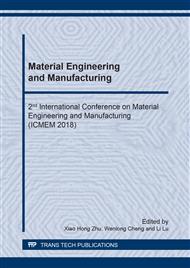[1]
A. Das, R. Alagirusamy, Science in Clothing Comfort, Woodhead Publishing India Pvt Limited, New Delhi, (2010).
Google Scholar
[2]
K.P.M. Tang, C.W. Kan, J.T. Fan, Psychological measurement of wet and clingy sensation of fabrics by the volar forearm test, Journal of Sensory Studies. 30 (2015) 329-347.
DOI: 10.1111/joss.12161
Google Scholar
[3]
K.P.M. Tang, C.W. Kan, J.T. Fan, Assessing and predicting the subjective wetness sensation of textiles: subjective and objective evaluation. Textile Research Journal. 85 (2015) 838-849.
DOI: 10.1177/0040517514555799
Google Scholar
[4]
K.P.M. Tang, K.H. Chau, C.W. Kan, J.T. Fan, Characterizing the transplanar and in-plane water transport property of fabrics under different sweat rate: forced flow water transport tester. Scientific Reports. 5 (2015) 17012.
DOI: 10.1038/srep17012
Google Scholar
[5]
K.P.M. Tang, Y.S. Wu, K.H. Chau, C.W. Kan, J.T. Fan, Characterising the transplanar and in-plane water transport of textiles with gravimetric and image analysis technique: spontaneous uptake water transport tester. Scientific Reports. 5 (2015).
DOI: 10.1038/srep09689
Google Scholar
[6]
T. Yasuda, M. Miyama, H. Yasuda, Dynamic water vapour and heat transport through layered fabrics, Part I: effect of surface modification, Textile Research Journal. 61 (1991) 10-20.
DOI: 10.1177/004051759106100102
Google Scholar
[7]
T. Yasuda, M. Miyama, H. Yasuda, Dynamic water vapour and heat transport through layered fabrics, Part II: effect of chemical nature of fibres, Textile Research Journal. 62 (1992) 227-235.
DOI: 10.1177/004051759206200407
Google Scholar
[8]
T. Yasuda, M. Miyama, H. Yasuda, Dynamic water vapour and heat transport through layered fabrics, Part III: surface temperature change, Textile Research Journal. 64 (1994) 457-465.
DOI: 10.1177/004051759406400805
Google Scholar
[9]
J. Fan, L. Hunter, Engineering Apparel Fabrics and Garments, Woodhead Publishing Limited, Cambridge, (2009).
Google Scholar
[10]
C.W. Kan, C.M.K. Ko, K. Ariyakuare, R. Mongkholrattanasit, Evaluating the warmth retention ability of polyurethane foam plying with fabrics. The 7th RMUTP International Conference on Science, Technology and Innovation for Sustainable Development. Bangkok, Thailand, 23-24 June (2016).
DOI: 10.4028/www.scientific.net/amm.866.233
Google Scholar
[11]
C.W. Kan, C.M.K. Ko, W. Changmuang, R. Mongkholrattanasit, Examining the air permeability of polyurethane foam plying with fabrics. The 7th RMUTP International Conference on Science, Technology and Innovation for Sustainable Development. Bangkok, Thailand, 23-24 June (2016).
Google Scholar


